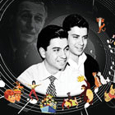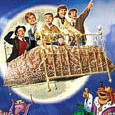Very few films have known such a complicated and painful path to the screen as Bedknobs And Broomsticks.
Considered at its starting point as a replacement movie in case Walt Disney didn’t obtain P.L. Travers’ agreement to make a filmed adaptation of her Mary Poppins books, it was initiated with passion and excitement by its creators, Bill Walsh, Don Da Gradi, and the Sherman brothers. Put on a hiatus because of the finally greenlit launch of Poppins, its pre-production started again in 1968, just before the Shermans left the Studio, to be stopped and restarted again (for good) for a 1971 release.
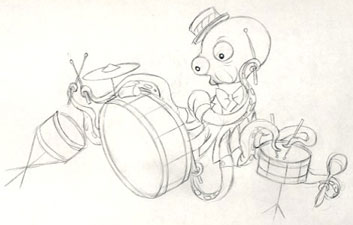
Yet, the story doesn’t end there.
In order to be presented at the New York City Hall Christmas show, Bedknobs And Broomsticks had to be shortened, and as the economic interests took precedence over artistic ambitions, it was the song sequences that came to be sacrificed on the altar of promotion. It was not until 25 years later that Scott MacQueen took charge of the restoration of this masterpiece, originally hardly recognized by audiences, and managed to put back many of the musical sequences it had been deprived of, although some other elements remained lost.
It is that adventure, made with as many joys as frustrations, which we had the pleasure and honor to talk about with one of the film’s legendary songwriters, Richard M. Sherman. In our conversation, we also evoked present ventures that he is concerned with, such as The Sherman Brothers Songbook 2-CD set and the documentary The Boys: The Sherman Brothers’ Story.

Animated Views: I believe the conception of Bedknobs And Broomsticks began as a replacement project at a time when Walt Disney wasn’t sure he would get the rights to adapt Mary Poppins?
Richard M. Sherman: Yes. He wanted to do a magical story, a live action magical story. In that regard, Bedknobs and Poppins both had things in common – of course, very, very little other than the British background and a lady-heroine who is a magician. Other than that, the stories were totally different.
AV: Just like for Mary Poppins, you took an active part in the story conferences right from the beginning of the film’s conception, back in 1963. How did you adapt the two original books that constituted the original material of the film, The Magic Bed Knob; Or, How To Become A Witch In Ten Easy Lessons and Bonfires And Broomsticks by Mary Norton?
RMS: Here is the thing. We started with a concept which was kind of fun: an amateur witch who wants to do something with her magic to help the war effort. What we felt was that we were more interested in the premise of the book, which we found wonderful, than in the story itself. The characters were wonderful. So, instead of having them go back in time, to a magician centuries ago, to find some of his magic power [in the original book, the children and Miss Price rescue a necromancer from the sixteenth century, Emelius, who is about to be burned at the stake for sorcery; to make a happy ending, the necromancer and Miss Price fall in love and return to the sixteenth century], we decided to have her go to a phony magician, which is fun. He sells magic tricks and he has no ability himself. Instead of being a magician of the dark ages, we changed Emelius Brown to a fellow in London who is kind of a snake-oil salesman. Basically, it gave this character a lot of fun. The hero of this story truly has to be Bill Walsh. He was the guy who made the conversion and made the story viable which, I thought, was kind of special. We had a lot of fun writing the songs for this thing. I must say it was always fun working with Walsh and Da Gradi, the writers. Da Gradi visualized everything and made things happen directly before your eyes as he talked. It was wonderful.
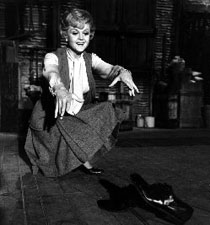
The same team, basically, who had created Poppins over a period of time, created the final version of Bedknobs And Broomsticks. But the initial version was far from perfect. It had some songs going and it was kind of fun, but we had this meeting and Walt said, “I think we have a long way to go on this one!” And about that time, we had the “go-ahead” to really start working on the Poppins project, because Ms. Travers had finally okayed our initial work. So, we could go back to Poppins, and we didn’t go back to Bedknobs until a few years later.
AV: There’s this famous sketch by Don Da Gradi showing Walt Disney sleeping during your presentation of the Eglantine, Eglantine song!…
RMS: We were so carried away telling our story and singing loud “Eglantine, Eglantine, oh how you shine!”, showing how the phony guy, who finds this real witch who’s capable of doing magic, is so excited when he figures he’d make a fortune with her. This is the fun of the show, and Walt was sort of toddling off! He might have been tired that day, and Don Da Gradi immortalized it by doing a drawing.
AV: What do you think Walt wanted to express through that story?
RMS: He wanted to promote the heroism and the bravery of the British people at the lowest point in their history, when they were about to be invaded by Nazis, by the Germans, and their determination and sheer guts to fight back through a lady coming up with the idea of sending uniforms to war without soldiers in them. This was the concept and everybody loved the idea. We could just take these old armors and just them send them out to fight the battle without anybody getting killed! Which they did! It was a great idea: wouldn’t it be wonderful if mankind didn’t have to kill each other in wars?
Also, it was a salute to the bravery of the Brits who held the one country that fought the Nazis off. This was the whole thing in the Battle of Britain and then the Blitz: they fought everything, everybody off and they finally prevailed. For me, it was a wonderful statement, and being myself an anglophile – I have a lot of respect and love for the British people – I thought it was like a salute to them. In fact, there’s a little song that starts and ends the picture called The Old Home Guard, and there were these old, aged guys with their pickaxes and everything, ready to fight the Germans on the beaches and never surrender. And I love that Old Home Guard song: “They’re sailing for England / Oh! What a shame! Someone is after our Island again”. It was just this fantastic, true spirit that the Brits have. That was exactly the spirit that was being saluted in this picture. We very truly love the picture.
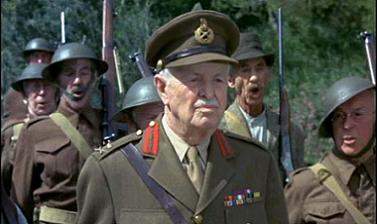
AV: How did Walt Disney receive the songs you composed at the time he was still there?
RMS: About half of the songs were composed after Walt passed away. It was 1963 and we had this meeting. I remember there were several songs, story/plot songs more than the emotional thing. I know he loved the Old Home Guard song and Eglantine, and I know he really loved With A Flair. “Oh, it doesn’t really matter what I do, what I do / As long as I do it with a flair!” It was the idea that Emelius Brown could sell anything. He didn’t believe anybody could do real magic, but he had this old magic book with the magic charm that makes Substitutiary Locomotion, and he sold it!
Also, Walt liked that song, Substitutiary Locomotion because it was the quest. That was the thing that Eglantine Price was searching for. And once she got that magical spell, she could actually send uniforms to war without soldiers in them. He loved the whole concept of that and was very enthusiastic. But I remember he said, “It’ll have to wait. It’s not ready yet, the story doesn’t quite jell”. And we knew that and it was not ’til many years later that the four of us got together again and started from page one, kept the good stuff and added some songs. That was in 1968, only a few months before we left the Studio.
AV: As the first songs you wrote were more story oriented, the new ones seemed to be more emotional and meaningful.
RMS: The later songs were very important because the tie-in song, the song that really made a lot of sense was the song that Eglantine sings to the little boy who doesn’t believe anything. She says, “You have to believe in something.” And she sings this song called The Age Of Not Believing that says that, if you can’t believe in yourself, you can’t believe in anything. So, she sings this song that has a great deal of meaning. I’ve always been really fond of the song. It was nominated for the Academy Award that year, because The Age Of Not Believing has a lot to say. It was something that Bob and I wrote because we had just come back to the Disney Studios having been away for almost two years, thinking, “What are we gonna do without Walt being around?” Because Walt was always there and said, “Yes, use this…. Don’t do this… I wanna change this…” He was the mastermind. So, we looked at each other and thought we had to believe in ourselves, now, believing that we knew what we’re doing. So, it really is a kind of an homage to Walt Disney.
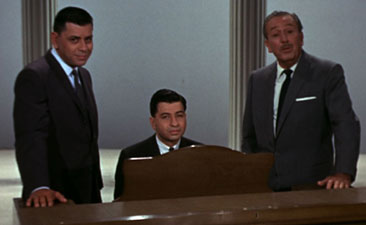
AV: Another key song important to the fleshing out of the characters is Nobody’s Problem.
RMS: A very important song, yes. Again, here’s the thing. I hate to go over sadness, but that was a very important song to us. Because it was not only the fact that Eglantine Price wanted to really have someone of her own, because she didn’t have anybody and she was all by herself, but also the fact that the children had lost their parents, they were actually orphans, war orphans, and had lost their parents in the Blitz. So, there we are with the kids and we had a song, a version of them singing, “Nobody’s problem are we.” And then, later in the story, when Eglantine realizes that she’s gonna be all by herself again, because after this wonderful experience together, Emelius went back. He was afraid to make commitments. He was afraid to say I love you. So, he ran away. And so, there was that beautiful reprise of the song, and it was very meaningful as such. Unfortunately, both versions were totally and completely ripped out of the picture. I’ll never forget how miserable we felt. That was the heartbeat of the picture and they took it out. I still feel very pained about that. Now, they found one version of it, the reprise and did a restored version with a beautiful vocal by Eglantine. But it would have had twice the poignancy if you’d heard those three little war orphans singing Nobody’s Problem early in picture. Then, you would have really cared about those kids. It was a very, very, very important song.
Here I am, going off on a rant on that, forty years later; but we put our lives into this picture, we truly did – we put our sweat, our blood, our dreams in it and they just sliced it out! You know what happened: they decided to obliterate the picture and they just sliced out songs, one after the other. So, for the first release version, we lost so much. It was so denuded of emotion that it was upsetting. The restored version, on DVD, restored a lot – not completely, but it was a far better film. I think certain things became too long. The dance routine in Portobello Road was much too long and they should have left it shorter. But that’s my comment.
AV: Certain proposed songs weren’t even produced, like Solid Citizen.
RMS: We had a song that we had written for Eglantine, because she’s the star, but they decided not to have it in the picture. At that point, there was a board of directors. There wasn’t a Walt Disney anymore. Seven or so men who got together and decided. The road to hell is paved with good intentions and so they got that idea to put in an animated sequence. So, they had an animated sequence of a soccer game and Eglantine is just watching the game: she has nothing to do! Whereas basically, we had a wonderful device. She was gonna sing a song to the lion king of Naboombu and while she was singing the song to distract his attention, Emelius would steal the medallion off of him. What we had originally was gonna be a wonderful sequence and they said, “Oh, no, no! We’re gonna do a different kind of thing. We’re gonna have a soccer game.” And so, they had a soccer game. So, you loose the entire interest of why Eglantine is even there. The focus was screwed over. I’m not knocking the sequence. I mean it was a very funny sequence, but doesn’t have anything whatsoever to do with the story.

AV: Can you tell me about the plot of the sequence you originally conceived for that moment?
RMS: We wanted to show that Eglantine Price had a personality, too. She had a lot of sense of humor. And, when they thought of a diversion, something that would divert the king of Naboombu, she said, “I know an old Cockney song. I’m gonna sing it. And while I’m singing this song, everybody is gonna sing with me. And while I’m doing this, you will steal the medallion”. So, it’s just a Cockney song, a silly song with a double meaning since it’s about a fellow who falls into the cement and becomes his own statue! It’s a typical, Cockney, English song like her father sang once, and she decided to use it as a device.
AV: Was there any deliberate intention in the choice of Walter as the name of this solid citizen?
RMS: No. That just felt good! We were not thinking of Walt at the time. It was just the manipulation of words. “Walter” seemed funny and sounded well, that’s all!
AV: Another song that was sliced is A Step In The Right Direction. Musically, the beginning of it reminded me of A Great, Big, Beautiful Tomorrow. Do you see any connection between these two songs?
RMS: Both songs were trying to make a strong, positive statement and I think I just inadvertently slipped into that phrase the second time not even thinking about it. They both have the same feeling, no question about it, the same kind of Disney spirit. When we first wrote the song for the General Electric pavilion at the World’s Fair, we were definitely thinking of Walt Disney. That was his whole philosophy of life. And we were trying to get that same energy going toward Eglantine. So, maybe just by thinking about that energy that Walt used to have, this positivism, I think we just fell into that phrase.
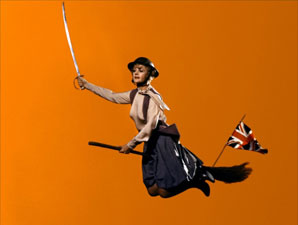
AV: Were you involved in any way in the choice of the casting of the film?
RMS: Actually, again, I want to give Bill Walsh complete credit for this. Walsh really produced this film. He was the co-writer and the producer. He actually ran the show there. He would kind of give us news about who he was thinking of and everything, and once he said Angela Lansbury, I was one of the many people who thought she was perfect. We were very excited about that. David Tomlinson came about in another way, we were going to use Ron Moody, who was a fine English actor. He played Fagin in Oliver. He was a very a good actor. Basically, he accepted the part, but then he decided he didn’t want to do it because he wasn’t the star – the star being the lady. So, he pulled out.
We needed a good, solid, English actor who could really do that phoney baloney and everything. There was David Tomlinson right in front of our eyes and we thought he’d be great. He played completely a different character than he played in Poppins, which was that very prim and proper Englishman. And now he was gonna be this funny Cockney, a totally different character. He loved the idea of playing totally against the character that he had established as his role in Poppins made him famous. He was really perfect and he and Angela worked so well, too. It was just a very good cast. We were very lucky to get them.
AV: It is said that Julie Andrews would have been interested in the leading role.
RMS: It’s possible, although by this point she was very committed to other pictures. She was doing one picture after another. I think she was doing Darling Lili or something and it took a lot of her time. So, it just was not possible anymore. We would have loved to have the two of them –Julie and David – reunited after Poppins, but that didn’t work.
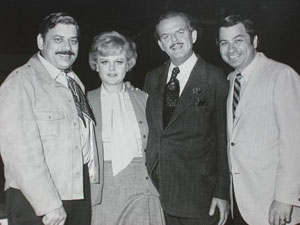
AV: What are your memories of Angela Lansbury and David Tomlinson on the set?
RMS: I can totally say that we had nothing but fun, laughter, a good time, never a bad or discouraging word ever. They were very cooperative. David was not a singer but he sang his heart out and he was so good. He did a wonderful job. And Angela, of course, was so completely ahead of everybody. She was always totally in control of what she was doing. She knew ahead of time what to do. She was the anchor so that everybody could follow her beat. She worked beautifully with everybody – a total professional. And then, a sweet, kind, lovely person. Not an ounce of ego. A really wonderful person!
AV: What was the process of recording the vocals like at that time?
RMS: In the course of doing a musical, what we always did was: we had a rhythm track, which is called a “temp track” and which was usually a piano, drums, bass and guitar, and that’s all. We recorded the vocals with that, which was actually against clicks and precise beats. And then what we did was, subsequent to that, add the orchestra. On occasions, if we needed to do like a set piece, we’d have an orchestra first and create the vocals after, but it was all separated stuff so that we could always improve it or change it or modify it. But most of the time, it was the rhythm track that they would sing to and then we added the orchestra. It was Irwin Kostal who did wonderful orchestrations of our songs and did a fabulous job.
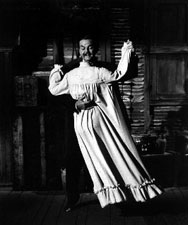
AV: How did you work with Robert Stevenson, the director, who had directed Mary Poppins (and many other Disney classics) before ?
RMS: Very rarely he came to recording sessions. He stayed away from that. He started working with what we gave him. In other words, we gave him a finished recording to work with, he would then take it and break it down into shots, determining how he wanted to shoot it. Basically, we didn’t have much to do with that. That was strictly Stevenson on his own. That’s the way it was with Poppins except that Walt Disney would tell Stevenson what he wanted. And this time, it was Stevenson doing it himself. Certain indications would come from Bill Walsh, but basically Stevenson directed it; it was his direction.
AV: Some of the titles we’ve just evoked and many other classics are going to be present along with rarities in the most anticipated 2-CD set The Sherman Brothers Songbook. Can you tell me about this great project?
RMS: 59 of our songs were beautifully restored so that they all sound like they were recorded last week! It’s incredible! I’m very thrilled. Randy Thornton runs the restorations and the preservation of the great soundtracks and everything. He’s a brilliant, brilliant record-man. He’s the one that assembled and created this thing. I had the big fun and fortune listening to some of the restoration when he was doing it, and it’s great. He’s so good at it. He selected from many, many of our pictures and highlights of the recordings that we’ve made over the years – soundtracks and straight recordings. Wonderful stuff! I’m tickled about that!
AV: Another great event is the release of the documentary The Boys: The Sherman Brothers’ Story, under the Disney brand.
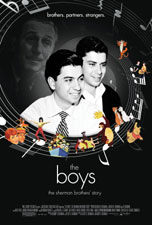
RMS: This I want to take no bow for, as this is strictly Gregory V. Sherman – my son – and Jeffrey C. Sherman – my brother’s son, my nephew. Greg and Jeffrey are the heroes and creators of this 1 hour and 40-minute documentary about the Sherman brothers. It tells the story of our relationship and writing together. We were totally in harmony and everything when it came to songwriting, but we went our separate ways as people because of many, many – let’s call it differences – in our lives and our thinking. But we would join together very emotionally and excitedly about our work. We loved working together and that’s one thing we did do.
AV: After so many years keeping that relationship private, what led you to accept to have a documentary based on that?
RMS: Well, one day, you’ll be a father. I hope someday you’ll have a kid. And one day that kid says, “I have a great idea. I want to do something. I’m burning up to do it!” You can’t say no to him. I thought it was nobody’s business that Bob and I went our separate ways in our lives, but that’s the gimmick which sold the idea to the Studio. Because I love my boy, I said, “Okay, son, if that’s what you really want to do.” I won’t tell why we went our separate ways. We went our separate ways, that’s it.
AV: I guess what’s most important for your fans all over the world is your music.
RMS: Exactly. It’s like anything else: people have their own reasons why certain things happen. The whole world didn’t have to know this but my son and my nephew thought this was gonna be a big thing for them and wanted to do this thing so badly. So, we answered yes. But we said the one thing that we’d keep is our privacy, and we did.
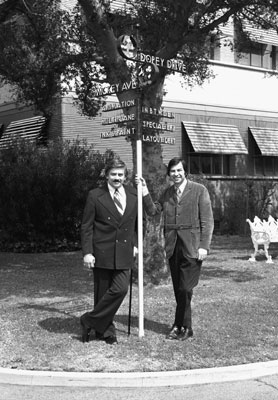
AV: That said, musically, don’t you think that that tension between you and your brother may have been an asset, in a way, a creative device?
RMS: I’ll put it this way. Bob and I both looked at the same thing coming from a different direction. We used to call it…we have a stereoptic look, you know, those things when you have depth. You look at a kind of a double picture and you can see in a sort of three-dimensional look. I think Bob and I have a stereoptical look about a lot of things. So we always modify each other’s thought. Bob would come in with a rather cryptic remark and I would soften it. That would be the thing I would do. Or I would come in with a really sweet, sugary thing and he’d put a little bit of a barb into it, to give it a little shot. And this is the way we worked back and forth. And we respected each other in that regard and listened to each other.
It was a very symbiotic relationship. We’d come in and we’d shape the world out and just think about the little stuffed teddy bear or the lonely lady who makes magic. Whatever it might be, we’d become part of that world. And that’s the way we survived in the world together. It was very productive and I must say we shared a great deal of happiness and joy when the things worked. When people said we did a great job, we shared a great deal of pride and excitement in that. There are a lot of things that we shared. It’s just that we did have a parting together.
AV: And among all the wonderful things you shared together, Bedknobs And Broomsticks is certainly one of the greatest.
RMS: Bedknobs And Broomsticks was kind of like a gift in a sense because it was something we started with great enthusiasm, had great hopes for. It didn’t quite come off as Walt had wanted it to do. But when it was restored, a lot of the great feel came back to it. There was a lot of love and heart and feeling in the picture and we’re still grateful for that. It’s very satisfying to have it now in the DVD version! The team who restored did a wonderful thing for us emotionally because, again, we saw what Walt really wanted for this picture…
is available to order now from Amazon.com
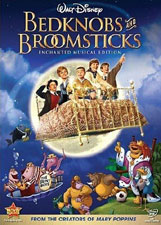
The Sherman Brothers Songbook 2-CD set
is available to pre-order now from Amazon.com
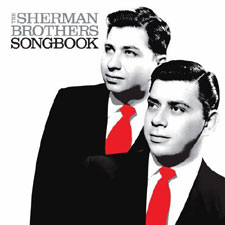
With all our gratitude and appreciation to Richard M. Sherman.
And many thanks to Olivier Mouroux and Randall, for the great help!



